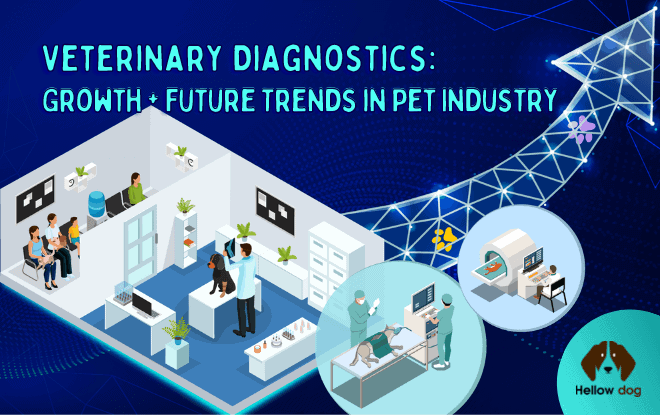The field of veterinary diagnostics is growing at a tremendous rate, driven by a demand for controlling and preventing diseases in our domesticated pets. As a result, there has been a staggering collection of data from animals (tissues, fluids) that help create these new, upgraded, and improved drugs and vaccines.
Developing more proper diagnoses is essential since threats to our animals lie in the unknown. Imagine the ability of more effective medical advancements that can help your pet thrive! Ultimately veterinarians are leaning hard on innovations and diagnostic tools to help supply improved results. The key to helping our pet community is to monitor diseases, from progression to prevention and response to treatment.

So, how will the growth of veterinary diagnostics help the pet industry? The components that makeup vet diagnostics will help create more advances in the identification of diseases and how pet owners are helping to drive the future of diagnostics.
Components of Veterinary Diagnostics
There are various components of the veterinary diagnostic system. The vet laboratory is the facility for medical testing, where vets and other knowledgeable professionals can submit and examine samples for analysis.
There are multiple kinds of testing laboratories that assess different samples for various diseases such as toxicology, virology, pathology, and bacteriology. In addition, there are veterinary instruments and tools for diagnostics that are utilized that include testing kits, needles, x-rays, and other surgical equipment.
Veterinary Diagnostic Methods
For the likes of Bond Vet online veterinarian, to provide the appropriate treatments and recovery tactics on calls, they must have diagnostic methods that are fast, specific, and cost-effective. Screening tests help vets determine if there is a possibility or susceptibility to disease, and then confirming diagnostics tests will help identify the illness within the animal.

Demand for new diagnostic testing has driven more efficiency for the testing and reduced the lag time for waiting on results. Modern diagnostic kits are accurate and easy to track, and they provide valuable information so that prevention and treatments can be more readily available for your pets.
The global veterinary market is expected to grow exponentially over the next few years, is valued at USD 6.63 billion in 2021, and is expected to increase at 11.2% by the year 2030. Most likely, this growth can be attributed to the increased animal population with pet adoption and healthcare costs on the rise.
New Diagnostics Tools
Some new biotechnological methods and tools enable veterinarians to use for more rapid and pinpointed diagnoses of animal illness. For example, biosensors can detect if there are any antibodies within pathogens using analytical tools.
In addition, nanotechnology has the potential to identify specific strains of diseases. Also, acid-based diagnostics help detect nucleic acids, and proteomics can look at protein patterns.
The biggest problem that stems from many of these new tools is the high cost associated with incorporating them. Keep that in mind when you have to bring your pet to the vet so that you’re not entirely overtaken by surprise by the cost of these types of diagnostics.

Being able to define the disease and understand what it comes from helps with the development of more effective treatments.
The best part of the emerging technology is that it even allows specific testing to recognize the dog breeds and analysis that can help determine any cause of their temperament or personality.
Likewise, diagnostic tools can provide insight into your pet’s skin problems, dental issues, and more. Dog breeders typically work with veterinarians in their facilities and look for various requirements or information regarding particular breeds so that they can relay this to new owners.
Veterinary Diagnostic Impact
Diagnostics encourage better pet health by looking at many aspects of what causes problems, from food safety and nutrition to human contact and antibiotic response. For example, vets and humans commonly use antibiotics to treat bacterial agents within the body, but the body has the ability to resist antibiotics eventually. With new and accurate diagnostic tests, vets can limit the unnecessary use of antibiotics for viruses when it is not required.
The need for fast and efficient diagnosis is in high demand. In addition, the lifespans of domesticated pets have risen in more recent years, and advances in diagnostics can help you be a more responsible pet owner and provide your furry companion with more longevity.

Final Thoughts
Knowing your pet can help you identify when things don’t seem right or feel your pet is suffering from an ailment. Unfortunately, since our pets can’t communicate with us, you don’t always understand when something might be wrong. The future of diagnostics can give your veterinarian the tools and equipment to better understand and diagnose your pet when it might otherwise not be showing any glaring symptoms.
The primary focus of diagnostics has begun to shift its focus more to cancer within animals since it is one of the most prominent diseases needing attention. Obtaining samples and establishing a more definitive and specific diagnosis is crucial for prevention and effective treatment plans.
Technology invested in vet diagnostics has a significant advantage and potential to improve the earlier detection of diseases, especially in areas where this type of testing is not established yet. The trend sees diagnostics for veterinarians to continue to improve and develop across the industry.







